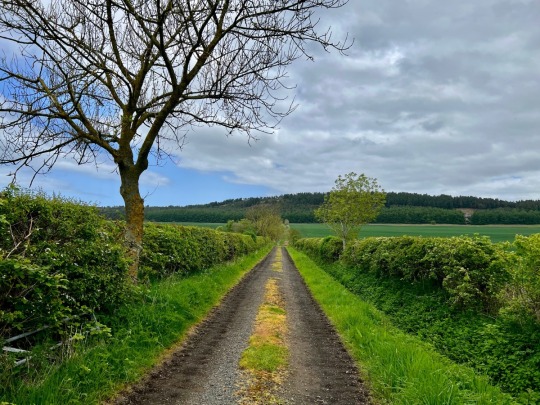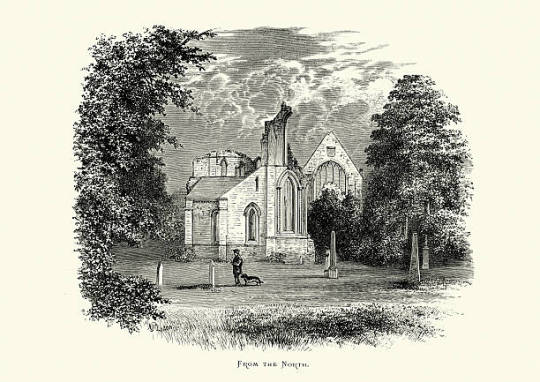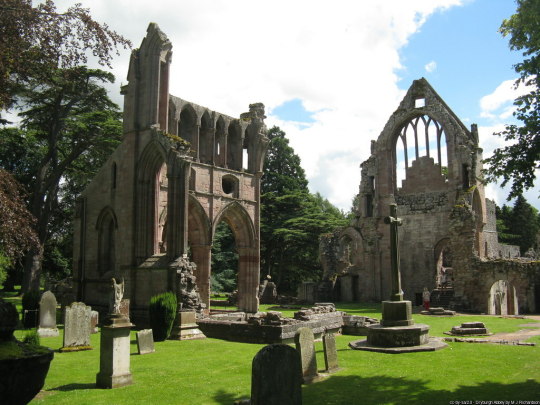#Dryburgh Abbey
Explore tagged Tumblr posts
Text
The Wallace Monument, or Barnweil Tower, Ayrshire
The gruesome tale is told that William Wallace, the famed Scottish soldier, stood on Barnweil Hill, near Tarbolton in Ayrshire, and watched as the barns in which he had trapped English soldiers were set alight. He is supposed to have uttered the words ‘The barns o’Ayr burn weel’, giving the spot its name. Few people seem to have genuinely believed this story, but in 1854 the decision was taken to…
#Ayr Town Council#Barnweil Hill#Barnweil Tower#Dryburgh Abbey#Sir William Wallace#Stirling#Tarbolton
0 notes
Text
Walking St. Cuthbert's Way
Photos, video and reflections from a beautiful 100 kilometer pilgrimage walk along the Scottish-English border.
St. Cuthbert, by local sculptor Tom Fiddes (2017), blesses the wayworn traveler. The saint stands opposite a country house offering shade and water to weary pilgrims. They confessed their sins, confided in him about their temptations, and laid open to him the common troubles of humanity they were laboring under … Spirits that were chilled with sadness he could warm back to hope again … Those…

View On WordPress
#Camino de Santiago#Dryburgh Abbey#Genesis 5:24#Holy Island#Jedburgh Abbey#John of the Cross#Melrose Abbey#Northumbria#pilgrimage#Rebecca Solnit#Scottish Borders#St. Aidan#St. Cuthbert&039;s Cave#St. Cuthbert&039;s Way#Venerable Bede#William Wordsworth
0 notes
Text
Historic site of the week: Dryburgh Abbey
Dryburgh Abbey in southern Scotland was founded in 1150. It was burned down by English army in the 15th century and abandoned after Reformation in 1544. Today beautiful ruins still remain.
0 notes
Text







On 10th November, the year 1150 work began on the construction of Dryburgh Abbey in the Scottish Borders.
Standing on an elevated site formed by a loop of the River Tweed about five miles from Melrose, Dryburgh Abbey’s seclusion is part of its undoubted charms that have captivated many souls down the ages. There is little of the original Abbey church left, but the remains of the sacristy and cloisters have survived and the building is well looked after now as it is in the care of Historic Environment Scotland.
At the time of its foundation Scotland was ruled over by the man who many people consider to be Scotland’s greatest king, David I, son of Malcolm Canmore and St Margaret of Scotland. He both ordered and funded the construction of several abbeys and monasteries as part of his Davidian Revolution which transformed the face of Scotland, but Dryburgh was not one of them.
There had been some sort of clerical institution at Dryburgh as far back as the early seventh century as ancient writings show that St Modan, a follower of St Columba, was described as being the abbot of Dryburgh in 622. As with all Scottish history from the Dark Ages and early mediaeval period, almost all records as existed about buildings and personalities have long been lost, and there is no physical evidence of the older establishment whatsoever.
Though approved by King David, Dryburgh Abbey was the foundation of Hugh de Morville or Moreville, a Norman knight who came over from Cotentin to northern England after King Henry I gave that part of northern France to David. He was almost certainly one of the French knights who helped David retain most of southern Scotland on behalf of his brother King Alexander I, known as the Fierce.
David was both the Earl of Huntingdon and the Prince of the Cumbrians which took in the area formerly occupied by the Kings of Strathclyde. David gave de Morville lands in Huntingdon and Westmoreland, so it would make sense that Hugh de Morville came into Scotland and took possession of lands given to him by David. He was also made Constable of Scotland after his predecessor was killed in battle in 1138.
Being allowed to build his own abbey shows how much he was appreciated by David. De Morville took a personal interest in the construction and shrewdly did not make it either as large or as powerful as those abbeys founded by David such as Holyrood and Melrose. With its location by the Tweed and the obviously intricate stonework that still survives,
Dryburgh Abbey was outstandingly beautiful. It was built quite quickly after de Morville was able to attract Premonstratien canons regular – not monks confirmed to a monastery but an order of preachers and pastors.The White Canons, as they were known from their robes, arrived from Alnwick Abbey at Dryburgh in 1152, and were soon joined by a prominent local lord, none other than Hugh de Morville who became a canon and died in the Abbey in 1162. His son, also Hugh, inherited his father’s lands in northern England and became infamous as one of the four knights who assassinated St Thomas a Becket, Archbishop of Canterbury, in 1170.
Dryburgh Abbey seems to have thrived until the Wars of Independence when it was burned down by the English army on their humiliating retreat from their 1322 invasion of Scotland under Edward II, loser of Bannockburn. They burned Holyrood and Melrose, too, and an enraged Robert the Bruce was appalled at the actions of supposed Christians, so much so that he gathered an army and charged deep into England in what was known as the Great Raid of 1322, routing the English army at the Battle of Old Byland to further humiliate Edward II who barely escaped with his life.
In 1385, another English army burned Dryburgh again, destroying the western frontage of the Abbey church. This was rebuilt, however, but by the time of King James IV, there was no longer sufficient canons in the Abbey which was handed over to a commendator – an administrator of church buildings appointed by the monarch.
Dryburgh was sacked twice more by the English in 1544, and when the Reformation took place in 1560 there were just 10 canons left, and they were all gone within a few decades. The Abbey was allowed to become a ruin, and passed into the control of various people until it was acquired in 1786 by David Erskine, 11th Earl of Buchan, founder of the Society of Antiquaries of Scotland. He re-created the ruin, added monuments and generally made the Abbey beautiful again .
Buchan died in 1829 and was buried in the Abbey. At one time the ruin was owned by the Haliburton family and they retained the right of burial within its walls. That is why the graves and memorial stones of Sir Walter Scott and Field-Marshal Earl Haig, both descendants of the Haliburtons, are there along with various members of their family.
Historic Environment Scotland says this about Dryburgh Abbey: “While a greater part of the abbey church is now gone, what does remain – principally the two transepts and west front – is of great architectural interest. The cloister buildings, particularly the east range, are among the best preserved in Scotland. The chapter house is important as containing rare evidence for medieval painted decoration. The whole site, tree-clad and nestling in a loop of the River Tweed, is spectacularly beautiful and tranquil.”
Dryburgh Abbey has become a place of pilgrimage for lovers of Scott in particular, but deserves to be better known because of its history and sheer beauty.
34 notes
·
View notes
Text


Dryburgh Abbey was founded in 1150 by Hugh de Morville the Elder, Constable of Scotland during the reign of David I , through gifts of land and money and given to the Premonstratensian Order.
27 notes
·
View notes
Text

Dryburgh Abbey
The remains of the abbey established in 1150 by Premonstratenian Canons. Since then it has suffered wars and fire, but a remarkable amount remains.
6 notes
·
View notes
Text

James Valentine - Dryburgh Abbey, Melrose Scotland St Catherine’s Window, 1871
0 notes
Text

Newtown St Boswells lies on the west side of the A68 a little south-east of Melrose and the Eildon Hills. It also lies just a mile north-west of St Boswells, something that causes considerable confusion as the name implies that Newtown is some recent offshoot of a more established village.
Newtown St Boswells is actually a very long established community, dating back to medieval times. And over the years it has adopted a variety of names, including Newtoun, Newton, Newtown of Eildon and Newtown of Dryburgh. The name Newtown St Boswells dates back to 1849 when the Edinburgh & Hawick Railway decided to give the station it opened in Newtown the name "St Boswells". As happened elsewhere, an arbitrary naming decision made by a railway executive came into common use.
Newtown originally grew as a centre for milling, with mills powered by the Bowden Burn as it made its way down to the nearby River Tweed. Amongst the first customers were the monks from Melrose Abbey who used Newtown's mills to process their grain.
The railway turned Newtown from a small agricultural village into a regional centre for the processing and transport of the produce of the fertile area between what is now the A68 and the coast. The railways that once connected Newtown to Edinburgh, Carlisle and Kelso have long gone, but traces remain. Perhaps the most spectacular is the 19 arch Leaderfoot Viaduct over the River Tweed two miles north of Newtown.
In 1899 Newtown's excellent transport links led to it becoming the focus of the county of Roxburghshire. Today it is home to the headquarters of Scottish Borders Council, a building that dominates much of Newtown and which was built in stages in the 1960s and 1980s as major extensions to the original Roxburgh County Buildings.
0 notes
Text

© Nona Limmen {Website / Instagram}
1K notes
·
View notes
Video
Dryburgh Abbey, Scotland by James Holland
553 notes
·
View notes
Text
The Temple of the Muses, Dryburgh, Borders.
The Temple of the Muses, Dryburgh, Borders.
The 11th Earl of Buchan, seldom mentioned without the qualifier ‘eccentric’, bought the Dryburgh estate towards the end of the 18th century. He built a new house and improved the grounds, creating a landscape which featured as its centrepiece that ultimate in garden ornaments: a ruined abbey. Further embellishments included this pretty rotunda on a hillock overlooking the Tweed, and a ‘colossal…

View On WordPress
#Apollo#Canmore#Coade Stone#David Steuart Erskine#Dryburgh Abbey#Earl of Buchan#James Thomson#River Tweed#Robert Burns#Siobhan O&039;Hehir#Society of Antiquaries of Scotland#Temple of the Muses#William Wallace
0 notes
Photo

Dryburgh Abbey by jbrochmann
1 note
·
View note
Photo

Scotland 1977
(source)
3 notes
·
View notes
Text




On October 24th 1796 the artist, David Roberts, was born in Edinburgh.
The son of a shoemaker, who began his career as an apprentice house painter. Roberts was born in Stockbridge, near Edinburgh, and while a boy he was a frequent visitor to Rosslyn Chapel, it’s architecture is a complex fusion of influences from many cultures, and it has been mentioned that it was an immense inspiration to the painter.
At the age of 19, after studying art formally at night, Roberts became foreman of work at Scone Palace for a time. Returning home in search of a new job at the end of the project, he took work as a scenery painter for James Bannister’s circus. Bannister offered him more work, engaging him on a good salary of 25 shillings a week, and for a while Roberts toured the country with the circus.
Through Bannister, Roberts then found work at the Pantheon Theatre in Edinburgh, but when the venture failed, he returned to his trade of house painter and decorator. All the time he was working on the “day job”, he was also practising his sketching and painting, thus developing his fine art skills.
Roberts returned to painting scenery for theatres in Edinburgh and Glasgow, meeting his wife, the actress Margaret McLachlan, at the Theatre Royal in Edinburgh. They had one child, Christine. In the early 1820s he exhibited work at the Fine Arts Institution in Edinburgh, including scenes of the abbeys of Melrose and Dryburgh, which were popular themes due to the immense interest in the history of the Anglo-Scottish border created by the work of Walter Scott.
Roberts was offered work in London, at first by the Coburg Theatre and then the Theatre Royal in Drury Lane. Soon Roberts was commissioned to work for Covent Garden, while also successfully exhibiting at the British Institution. Gothic, romantic and religious themes were still popular in art and Roberts continued to produce paintings of Scottish abbeys and famous European Cathedrals. He developed his range into landscapes and seascapes, as well as Biblical and antiquarian themes, achieving fame though his painting “Departure of the Israelites from Egypt”.
Roberts began to travel in 1832, producing a series of lithographs from his trip to Spain and Morocco. In 1838, he embarked on a tour of Egypt, Nubia, Sinai, Syria and the Holy Land, and his sketches, paintings and lithographs were hugely in demand on his return. Publication of “Sketches in the Holy Land and Syria, 1842–1849” and “Egypt & Nubia” followed, volumes that ran to many editions and are still popular as reprints today.
When he returned to Scotland, the Royal Scottish Academy feted him at a public dinner. As a result of this, Roberts advised the Academy that he was worried about work that was being done at Rosslyn Chapel. One of the major architectural conflicts of the time was between the “romantic school” who viewed overgrown buildings as beautiful in their own right, even seeing the moss and overgrowth as protective, and those who wished to restore and preserve buildings.
When he returned to Scotland, the Royal Scottish Academy feted him at a public dinner. As a result of this, Roberts advised the Academy that he was worried about work that was being done at Rosslyn Chapel. One of the major architectural conflicts of the time was between the “romantic school” who viewed overgrown buildings as beautiful in their own right, even seeing the moss and overgrowth as protective, and those who wished to restore and preserve buildings.
Roberts also visited Italy in the early 1850s, producing a volume of paintings entitled “Italy, Classical, Historical and Picturesque”. The last 15 years of his life were spent carrying out prestigious projects such as the painting of the opening of the Great Exhibition of 1851. He became a member of the Royal Academy and was given the freedom of Edinburgh. His distinctive style and intuitive interpretation of light were emulated by many artists who came after him.
The last time I posted about David Roberts I featured his work in Palestine and Egypt, the pics this time around are his home grown work, the first being a self portrait, next is his apparent inspiration, the Entrance to the Crypt, Rosslyn Chapel, St. Mungo’s Cathedral, Glasgow and Dumbarton Rock.
If you want to see more of his work check out the Royal Academy's site here.https://www.royalacademy.org.uk/art.../name/david-roberts-ra
8 notes
·
View notes
Photo

Entrance to the Chapter House at Dryburgh Abbey in the Scottish Borders.
9 notes
·
View notes
Photo

George Washington Wilson - Dryburgh Abbey - St. Catherine Wheel - Window in the Refectory, 1865
253 notes
·
View notes